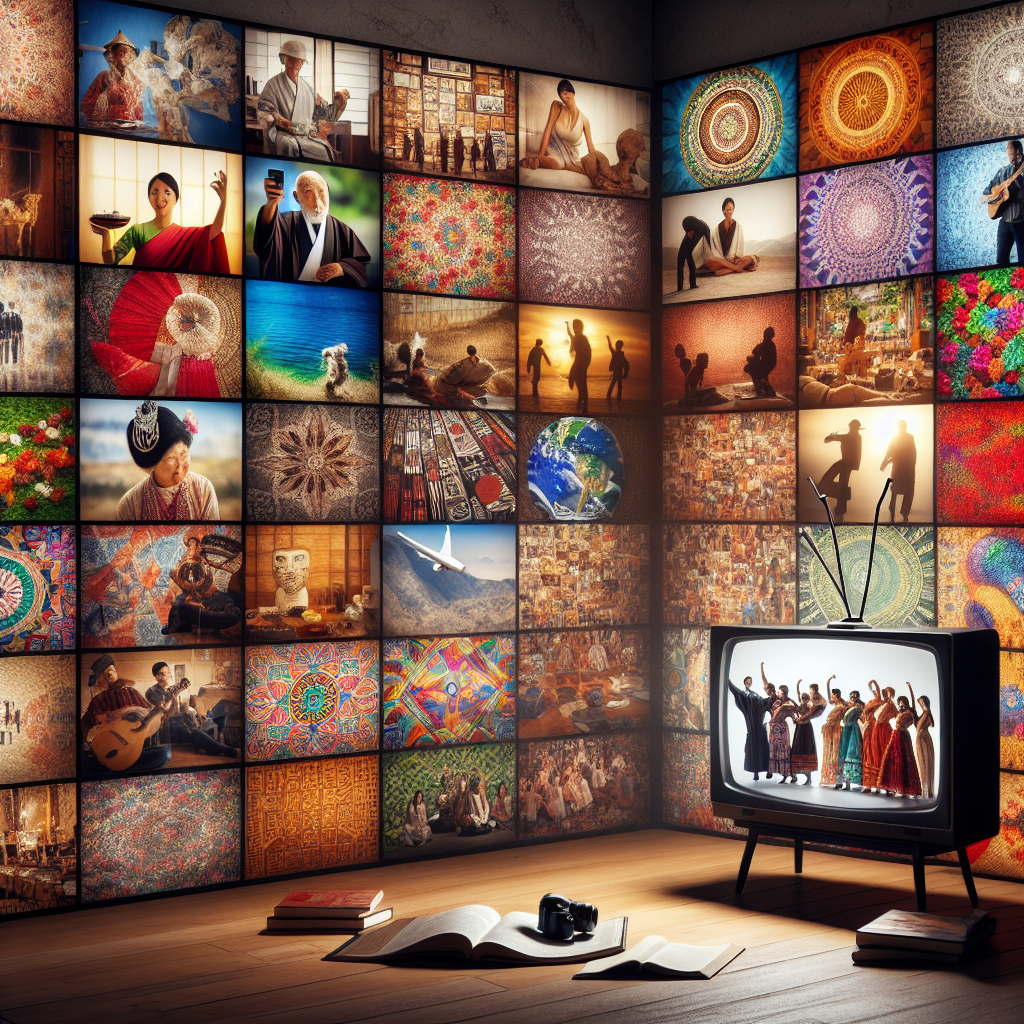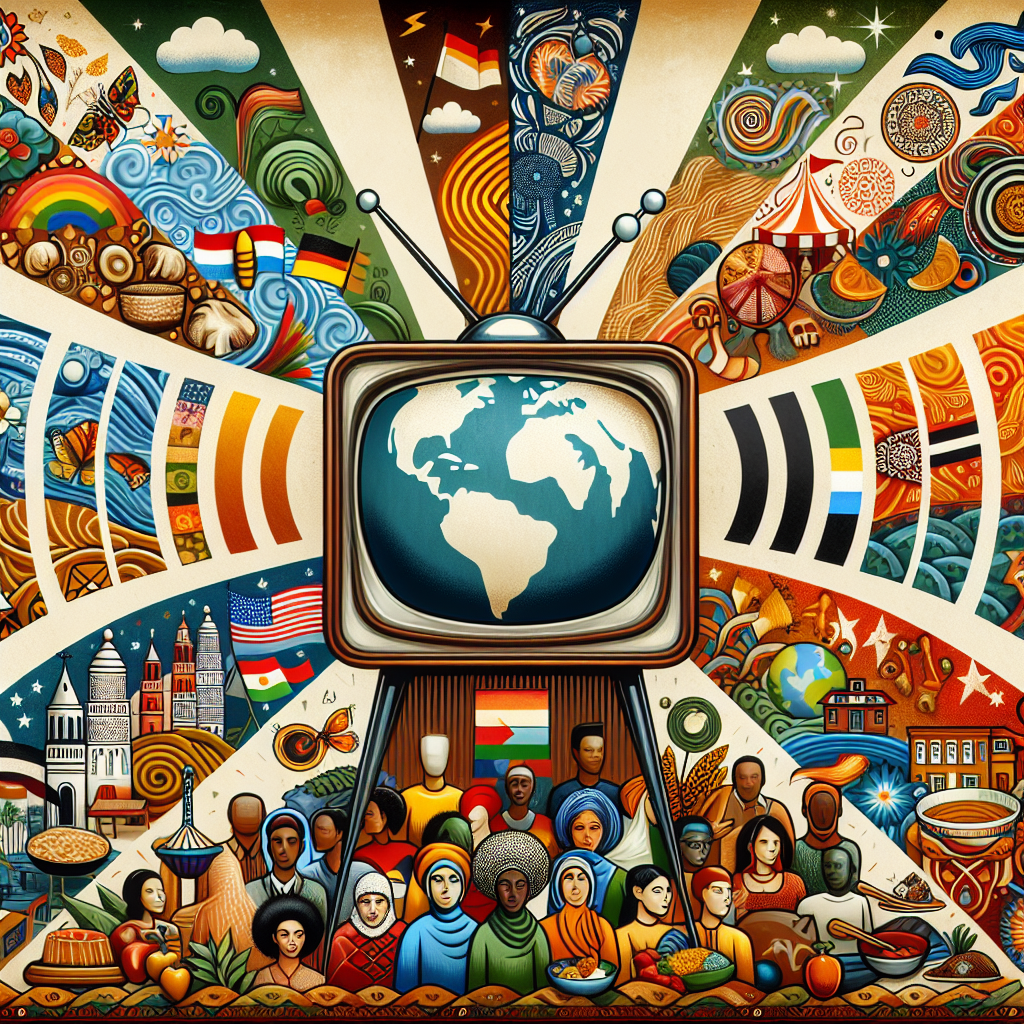In today’s interconnected world, cultural exchange TV channels play a pivotal role in facilitating cross-cultural understanding and appreciation. These channels serve as a window into different cultures, traditions, and customs, allowing viewers to broaden their horizons and embrace diversity. Through a comprehensive analysis, we will delve deep into the impact of such channels on society, shedding light on how they promote tolerance, empathy, and global awareness. From showcasing international films and documentaries to celebrating unique festivals and traditions, cultural exchange TV channels bridge the gap between nations and foster a sense of unity in diversity. Join us on this enlightening journey as we unveil the transformative power of cultural exchange TV channels.
Understanding Cultural Exchange TV Channels
Cultural Exchange TV Channels serve as platforms for promoting intercultural dialogue and understanding through the broadcasting of diverse cultural content. These channels aim to bridge the gap between different societies by showcasing a wide range of cultural expressions, traditions, and perspectives. By facilitating the exchange of ideas, values, and beliefs, Cultural Exchange TV Channels play a crucial role in fostering mutual respect and appreciation among global audiences.
Definition of Cultural Exchange TV Channels
Cultural Exchange TV Channels can be defined as television networks dedicated to promoting cross-cultural communication and interaction. These channels typically feature programs that highlight the cultural heritage, customs, arts, music, cuisine, and lifestyles of various regions around the world. Through documentaries, films, music showcases, and reality shows, Cultural Exchange TV Channels offer viewers a window into different cultures, enabling them to gain insights into the diversity of human experiences.
Purpose and Importance in Today’s Globalized World
In today’s globalized world, Cultural Exchange TV Channels serve as vital tools for promoting cultural diversity, tolerance, and understanding. As societies become increasingly interconnected, it is essential to foster a sense of empathy and respect for other cultures. These channels help break down stereotypes, challenge prejudices, and promote intercultural dialogue, thus contributing to the creation of a more inclusive and harmonious global community. Furthermore, Cultural Exchange TV Channels play a significant role in preserving and promoting endangered cultural traditions, languages, and practices, ensuring their visibility and survival in the digital age.
The Significance of Cultural Exchange TV Channels
Enhancing Cultural Awareness
Cultural exchange TV channels play a pivotal role in enhancing cultural awareness among viewers through a variety of mechanisms. These channels serve as powerful platforms for promoting cross-cultural understanding and appreciation. By showcasing diverse cultural practices, traditions, and values, they facilitate a deeper insight into the richness and diversity of global cultures.
Promoting Understanding of Different Cultures
One of the primary ways in which cultural exchange TV channels enhance cultural awareness is by exposing viewers to a wide array of cultural expressions from around the world. Through documentaries, travel shows, and cultural programs, audiences are able to gain firsthand exposure to the customs, rituals, and lifestyles of different societies. This exposure fosters empathy and respect for cultural differences, leading to a more inclusive and tolerant global community.
Breaking Stereotypes and Misconceptions
Moreover, cultural exchange TV channels play a crucial role in breaking down stereotypes and misconceptions that may exist about certain cultures. By presenting authentic and nuanced portrayals of diverse communities, these channels challenge preconceived notions and encourage viewers to question their biases. This process of deconstructing stereotypes helps in fostering a more open-minded and culturally sensitive worldview among audiences.
Fostering Cross-Cultural Communication
The Significance of Cultural Exchange TV Channels
Cultural exchange TV channels play a pivotal role in fostering cross-cultural communication by serving as platforms that transcend geographical boundaries and language barriers. Through a diverse range of programs and content, these channels facilitate meaningful interactions between individuals from different cultural backgrounds, thereby promoting mutual understanding and appreciation.
- Facilitating Dialogue and Interaction Among Cultures
By showcasing a variety of cultural practices, traditions, and values, cultural exchange TV channels create opportunities for audiences to engage in dialogue and exchange perspectives. Viewers are exposed to a wide array of cultural expressions, leading to increased empathy and respect for diverse ways of life. Through interviews, documentaries, and cultural showcases, these channels spark conversations that bridge cultural divides and promote a sense of global interconnectedness.
- Encouraging Cultural Diplomacy and Cooperation
Cultural exchange TV channels serve as powerful tools for cultural diplomacy, as they enable nations to showcase their cultural heritage and artistic achievements on a global stage. By promoting cultural exchange and collaboration, these channels contribute to building bridges between nations and fostering international cooperation. Through joint productions, co-hosted events, and collaborative initiatives, cultural exchange TV channels play a vital role in promoting peace and understanding among nations.
In conclusion, the role of cultural exchange TV channels in fostering cross-cultural communication cannot be overstated. By facilitating dialogue, promoting interaction among cultures, and encouraging cultural diplomacy, these channels serve as catalysts for promoting a more interconnected and harmonious global community.
Exploring the Diversity of Content Offered
Cultural exchange TV channels serve as a platform for a diverse array of content that showcases the richness and uniqueness of cultures from around the world. These channels play a vital role in bridging gaps between societies and fostering a greater understanding of global diversity. Let’s delve into the specifics of the content offered on these channels:
- Variety of Programming from Around the World
Cultural exchange TV channels curate a wide range of programming that encompasses various genres such as documentaries, travel shows, cooking programs, music concerts, and drama series. Each program is carefully selected to provide viewers with a glimpse into the cultural fabric of different countries. For instance, viewers may have the opportunity to explore the ancient traditions of Japan through a historical documentary one day, and immerse themselves in the vibrant festivals of Brazil through a travel show the next.
- Showcasing Traditions, Customs, and Lifestyle of Different Countries
One of the primary objectives of cultural exchange TV channels is to offer a nuanced portrayal of the traditions, customs, and lifestyle practices prevalent in different parts of the world. Through in-depth documentaries and immersive cultural showcases, viewers can gain insights into the daily lives of people from diverse backgrounds. This not only fosters cultural appreciation but also promotes cross-cultural dialogue and empathy among viewers. Whether it’s a feature on traditional clothing in India or a series on culinary traditions in Italy, these channels play a pivotal role in celebrating the richness of global cultural heritage.
Impact on Viewers and Society

Influence on Cultural Perceptions
- Shaping Viewers’ Perspectives on Different Cultures
Cultural exchange TV channels play a crucial role in shaping viewers’ perspectives on different cultures by providing authentic and immersive insights into various traditions, customs, and ways of life. Through engaging storytelling, documentaries, and educational programs, these channels offer viewers a window into the rich tapestry of global diversity. By showcasing the everyday lives of individuals from different cultural backgrounds, these channels help break down stereotypes and misconceptions, fostering a deeper understanding and appreciation for the complexities of diverse cultures.
- Promoting Respect for Diversity and Inclusivity
One of the key impacts of cultural exchange TV channels is their ability to promote respect for diversity and inclusivity within society. By highlighting the similarities and shared human experiences across different cultures, these channels emphasize the universal values of compassion, empathy, and tolerance. This exposure to diverse cultural perspectives encourages viewers to embrace cultural differences as opportunities for learning and growth, ultimately fostering a more inclusive and harmonious society.
Social and Emotional Impact
Cultural exchange TV channels play a crucial role in shaping the social and emotional landscape of viewers and society at large. Through their diverse programming and content, these channels have been instrumental in fostering empathy and understanding among individuals from different cultural backgrounds.
Fostering Empathy and Understanding
By showcasing a wide array of cultural practices, traditions, and beliefs, cultural exchange TV channels provide viewers with unique opportunities to step into the shoes of others and gain a deeper appreciation for diversity. Through compelling storytelling and immersive experiences, these channels challenge stereotypes and prejudices, ultimately fostering empathy and compassion among their audiences.
Building Bridges Across Borders and Communities
Moreover, cultural exchange TV channels serve as powerful tools for building bridges across borders and communities. By highlighting commonalities and celebrating differences, these channels facilitate dialogue and promote cross-cultural communication. Through shared experiences and shared narratives, viewers are able to forge connections with individuals from around the world, breaking down barriers and fostering a sense of global citizenship.

Challenges and Limitations
Cultural Sensitivity and Appropriation
hallenges and Limitations
Cultural exchange TV channels face a myriad of challenges when it comes to navigating the intricate landscape of cultural sensitivity and appropriation. This section delves into the complexities surrounding these issues and the impact they have on the content and reception of such channels.
- Balancing Authentic Representation with Entertainment
Maintaining a delicate balance between authentic representation of diverse cultures and the need for entertainment value is a constant tightrope walk for cultural exchange TV channels. While it is crucial to showcase various cultural practices, traditions, and beliefs accurately, there is also a pressure to engage and captivate audiences to ensure viewership and commercial success. This dilemma often leads to the portrayal of stereotypes or oversimplified versions of cultures, which can be detrimental to promoting genuine cultural understanding and appreciation.
- Addressing Controversies and Criticisms
Cultural exchange TV channels frequently find themselves embroiled in controversies and criticisms related to cultural appropriation. This occurs when elements of a particular culture are adopted or utilized without proper understanding, respect, or permission, often leading to misrepresentation or distortion of cultural heritage. Such missteps can result in backlash from communities whose cultures are being misrepresented, damaging the reputation and credibility of the channel. Navigating these controversies requires a nuanced approach that involves actively listening to feedback, engaging in constructive dialogue with stakeholders, and making necessary adjustments to ensure cultural sensitivity and authenticity are prioritized.
Language and Accessibility Barriers
Cultural exchange TV channels play a crucial role in breaking down barriers and fostering cross-cultural understanding. However, they face several challenges and limitations, particularly concerning language and accessibility issues. By delving into these barriers, we can gain a deeper understanding of the impact of cultural exchange TV channels on global audiences.
- Overcoming Language Differences for Global Audiences
One of the primary challenges faced by cultural exchange TV channels is the diverse linguistic landscape of their viewers. To effectively reach a global audience, these channels must navigate the complexities of language differences. This involves not only providing subtitles or dubbing in multiple languages but also ensuring that cultural nuances are accurately conveyed in translations. Failure to address language barriers can hinder the ability of these channels to truly connect with viewers from different cultural backgrounds.
- Ensuring Equal Access to Diverse Cultural Content
Accessibility is another key concern for cultural exchange TV channels. While they aim to promote cultural diversity and mutual understanding, disparities in access to technology and media platforms can limit the reach of their content. Ensuring equal access to diverse cultural content requires strategies to make programming available on a variety of platforms, including traditional television, streaming services, and online platforms. Additionally, efforts must be made to address digital divides and ensure that marginalized communities have the opportunity to engage with the content offered by these channels.

Overall, addressing language and accessibility barriers is essential for cultural exchange TV channels to fulfill their mission of promoting intercultural dialogue and fostering a more inclusive global media landscape.
Future Prospects and Trends
As cultural exchange TV channels continue to evolve, several future prospects and trends are shaping the landscape of cross-cultural programming. These developments are crucial in understanding the impact and influence of such channels on global audiences.
Technological Innovations in Cultural Exchange TV Channels
Technological advancements play a pivotal role in enhancing the reach and effectiveness of cultural exchange TV channels. The integration of virtual reality (VR) and augmented reality (AR) technologies is revolutionizing the way audiences engage with content, allowing for immersive cultural experiences. Interactive platforms and personalized recommendations based on viewers’ preferences are becoming standard features, enabling a more tailored and engaging viewing experience. Furthermore, the rise of streaming services and on-demand content has paved the way for greater accessibility and flexibility in consuming cultural programming, transcending geographical boundaries.
Collaborations and Partnerships for Cross-Cultural Programming
Collaborations and partnerships between cultural exchange TV channels, content creators, and local production houses are becoming increasingly prevalent in the realm of cross-cultural programming. By joining forces, these entities can pool resources, expertise, and creative talents to produce high-quality content that resonates with diverse audiences. Such collaborations not only foster cultural exchange and understanding but also open up new avenues for storytelling and representation. Moreover, strategic partnerships with international broadcasters and distribution platforms enable cultural exchange TV channels to expand their global reach and impact, facilitating the exchange of ideas and perspectives on a broader scale.
FAQs: Unveiling the Impact of Cultural Exchange TV Channels: A Comprehensive Analysis
What are cultural exchange TV channels?
Cultural exchange TV channels are television networks dedicated to showcasing programming from various cultures around the world. These channels aim to promote cross-cultural understanding and appreciation by broadcasting content that highlights the diversity of global cultures.
How do cultural exchange TV channels impact viewers?
Cultural exchange TV channels have a profound impact on viewers by exposing them to new ideas, perspectives, and traditions from different parts of the world. By watching programs on these channels, viewers can broaden their worldview, challenge their own biases, and develop a greater understanding and appreciation for cultural diversity.
What types of programming can be found on cultural exchange TV channels?
Cultural exchange TV channels typically feature a wide range of programming, including documentaries, travel shows, cooking shows, music and dance performances, and cultural events coverage. These channels may also air foreign films, TV series, and news programs that offer insights into different cultural practices and beliefs.
How can viewers access cultural exchange TV channels?
Viewers can access cultural exchange TV channels through cable or satellite TV subscriptions, streaming services, or online platforms. Many of these channels are available as part of standard television packages or can be purchased as standalone subscriptions. Some channels also offer their programming for free on their websites or social media platforms.
What are some of the benefits of watching cultural exchange TV channels?
Watching cultural exchange TV channels can broaden one’s perspective, foster intercultural understanding, and promote empathy and tolerance towards different cultures. It can also inspire viewers to learn more about other cultures, travel to new destinations, and engage in meaningful cross-cultural interactions. Additionally, watching programming from diverse cultures can be a source of entertainment and enrichment for viewers.